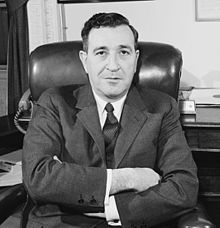
Back جيروم ويزنر Arabic جيروم ويزنر ARZ Jerome Wiesner German Jerome Wiesner Spanish جروم ویزنر Persian Jerome Wiesner Finnish Jerome Wiesner Malagasy Визнер, Джером Russian Jerome Wiesner Turkish 杰罗姆·威斯纳 Chinese
Jerome Wiesner | |
|---|---|
 | |
| 13th President of the Massachusetts Institute of Technology | |
| In office 1971–1980 | |
| Preceded by | Howard Johnson |
| Succeeded by | Paul Gray |
| Director of the Office of Science and Technology | |
| In office January 20, 1961 – January 24, 1964 | |
| President | John F. Kennedy Lyndon B. Johnson |
| Preceded by | George Kistiakowsky |
| Succeeded by | Donald Hornig |
| Personal details | |
| Born | Jerome Bert Wiesner May 30, 1915 Detroit, Michigan, U.S. |
| Died | October 21, 1994 (aged 79) Watertown, Massachusetts, U.S. |
| Spouse | Laya Wainger |
| Education | University of Michigan (BS, MS, PhD) |
| Awards | IEEE Founders Medal (1977) Vannevar Bush Award (1992) |
| Scientific career | |
| Fields | Electrical engineering |
| Institutions | Massachusetts Institute of Technology Los Alamos Laboratory |
| Thesis | Pre-ignition phenomena in gas switching tubes and related rectifier burnout problems (1950) |
Jerome Bert Wiesner (May 30, 1915 – October 21, 1994) was a professor of electrical engineering, chosen by President John F. Kennedy as chairman of his Science Advisory Committee (PSAC). Educated at the University of Michigan, Wiesner was associate director of the university's radio broadcasting service and provided electronic and acoustical assistance to the National Music Camp at Interlochen, Michigan. During World War II, he worked on microwave radar development at the MIT Radiation Laboratory. He worked briefly after the war at the Los Alamos National Laboratory, then returned to MIT's Research Laboratory of Electronics from 1946 to 1961. After serving as Kennedy's science advisor, he returned to MIT, becoming its president from 1971 to 1980.
He was an outspoken critic of crewed exploration of outer space, believing instead in automated space probes. He challenged NASA's choice of developing the Apollo Lunar Module as a means to achieving Kennedy's goal of landing men on the Moon. At Kennedy's direction, he investigated Rachel Carson's criticism of the use of the pesticide DDT, and issued a report in support of her claims. He was an advocate for arms control, and a critic of anti-ballistic missile defense systems. While MIT president, he was put on President Richard M. Nixon's extended "enemies list".